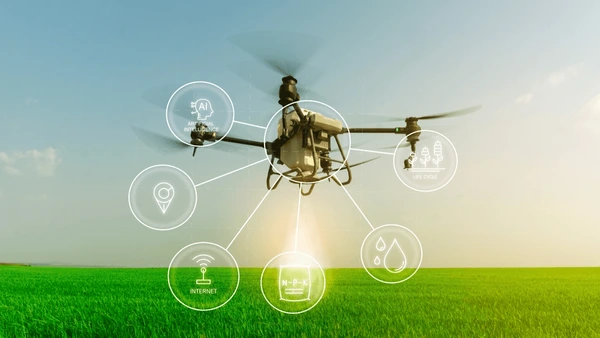Saturday, 22 November 2025


In an era where climate vicissitudes imperil the global food supply, Agnishwar Jayaprakash, Founder and CEO of Garuda Aerospace, elucidates the transformative potential of artificial intelligence and drones in crop protection. He contends that conventional agriculture, long reliant on predictable patterns, is now imperilled by erratic rainfall, extreme temperatures, and emergent pests. By harnessing AI’s analytical prowess, farmers can discern early signs of disease and stress, converting sprawling datasets into prescient decisions that safeguard yields. Complementing this cerebral intelligence, drones provide a synoptic and precise gaze over vast tracts, enabling targeted interventions in irrigation, spraying, and soil analysis. Jayaprakash further underscores the predictive alchemy of combining historical and real-time data, allowing agronomists to act with anticipatory precision rather than reactive expedience. Ultimately, he envisions a paradigm where technology does not merely augment farming, but partners in cultivating a sustainable, resilient, and environmentally consonant agricultural future.
Climate change is no longer a distant threat—it is a present reality that is reshaping every facet of agriculture. Unpredictable rainfall, rising temperatures, extended droughts, and extreme weather events are testing the resilience of conventional farming practices. For a world whose population is projected to reach 10 billion by 2050, ensuring food security is not just a challenge—it is an imperative.
In this context, the convergence of artificial intelligence (AI) and drone technology is emerging as a powerful force for transformation. By equipping farmers with real-time insights and precision tools, these technologies are turning agriculture from a reactive enterprise into a proactive, data-driven industry.
The Climate Challenge and the Need for Innovation
Traditional agriculture thrives on predictability. Yet today, climatic unpredictability invites new pests, diseases, and environmental stresses that conventional methods struggle to address. Early detection, rapid intervention, and precision management are no longer optional—they are essential. Farmers need solutions that are both scalable and cost-effective, enabling them to protect yields while safeguarding the environment.
AI: From Data to Decisions
Artificial intelligence is redefining what is possible in crop management. Machine learning algorithms analyze complex datasets—from soil health to crop conditions—to detect early signs of stress, disease, or infestation that the human eye might miss. By predicting outbreaks and optimizing interventions, AI helps farmers increase crop yields, reduce costs, and make informed decisions in a volatile climate. For instance, AI-driven insights combined with drone surveillance can save corn, soybean, and wheat farmers billions of dollars annually by preventing losses and improving resource efficiency.
Drones: Precision from the Sky
Drones provide unprecedented visibility and speed. High-resolution multispectral and hyperspectral imagery allows farmers to monitor hundreds of acres in a fraction of the time it would take manually. Drones can measure moisture levels, nutrient distribution, and plant health, producing actionable maps that guide precise interventions. Beyond monitoring, drones are now equipped for precision spraying, soil analysis, and irrigation management—reducing chemical use and optimizing resource application.
Early Detection and Precision Action
Disease detection has never been more precise. For example, AI-equipped drones can identify apple scab disease with up to 95 per cent accuracy, enabling timely treatment while minimizing pesticide use. Thermal and near-infrared imaging provide further insight into plant stress, guiding irrigation and nutrient application in a targeted, environmentally responsible manner. This two-pronged approach—early detection coupled with precision action—drives both economic and ecological sustainability.
Predictive Analytics: Farming Ahead of the Curve
Perhaps the most powerful advantage of AI-driven drone technology is predictive analytics. By analyzing historical and real-time environmental data, AI can forecast pest outbreaks, disease risks, and optimal planting or harvesting windows. Farmers can now act in anticipation rather than reaction, safeguarding yields despite unpredictable weather.
A Sustainable Path Forward
AI and drone integration is not just a productivity tool—it is a climate-conscious strategy. By reducing chemical inputs, optimizing resource usage, and protecting biodiversity, these technologies align with climate-smart agricultural practices. Sustainable, precise, and efficient, they help farmers grow more while leaving a lighter footprint on the planet.
Market Momentum and Global Adoption
The impact of this technology is tangible. In India, the agricultural drone market is expected to reach $ 631.4 million by 2030. Globally, AI adoption in agriculture is projected to reach $ 4.7 billion by 2028, with a CAGR of 23.1 per cent. These numbers reflect a fundamental shift in how agriculture is practiced—where technology empowers farmers to thrive amid climate challenges.
A New Era for Agriculture
We stand at the cusp of a revolution. AI and drones are enabling farmers to protect crops more efficiently, sustainably, and profitably than ever before. In the face of climate uncertainty, this technology is not just a tool—it is a partner in building a resilient, productive, and sustainable agricultural future. The future of farming is not just about surviving change; it is about harnessing innovation to shape it.